Sun Science Stamps Highlight a Decade of Sun-Watching from Space
To start off the summer, the U.S. Postal Service issued a set of stamps highlighting views of the Sun from NASA’s Solar Dynamics Observatory. Showcasing a range of solar activity seen by the spacecraft, the stamps celebrate a decade of Sun-watching for this workhorse mission. The Sun Science stamps were issued by the U.S. Postal Service during a ceremony at the Greenbelt Main Post Office in Maryland on June 18.
“It’s such a pleasure to see these gorgeous stamps,” said Dr. Nicky Fox, Division Director for NASA’s Heliophysics Division at NASA Headquarters in Washington, D.C. “I look at each of these pictures from the Solar Dynamics Observatory and am reminded of how they help us learn more about the Sun and the way its constantly changing atmosphere can affect Earth and the planets. I’m pleased that this imagery will be shared by the Postal Service with the whole country.”
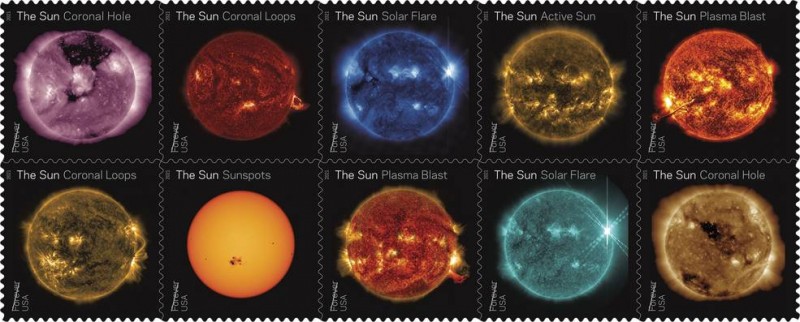
The U.S. Postal Service issued a set of stamps highlighting views of the Sun from NASA’s Solar Dynamics Observatory on June 18, 2021.
The Solar Dynamics Observatory, or SDO, spacecraft was launched on Feb. 11, 2010, and began collecting science data a few months later. With two imaging instruments – the Atmospheric Imaging Assembly and the Helioseismic and Magnetic Imager, which were designed in concert to provide complementary views of the Sun – SDO sees the Sun in more than 10 distinct wavelengths of light, showing solar material at different temperatures. SDO also measures the Sun’s magnetic field and the motion of solar material at its surface, and, using a technique called helioseismology, allows scientists to probe deep into the Sun's interior, where the Sun’s complex magnetic fields sprout from. And with more than a decade of observation under its belt, SDO has provided scientists with hundreds of millions of images of our star.
“What SDO has done is given us the ecology of the Sun,” said Dr. Dean Pesnell, SDO project scientist at NASA Goddard. “We see events big, we see events small, and now we start to see how each size affects the others. It’s giving us the big picture, one detail at a time.”
NASA's Solar Dynamics Observatory sees the Sun in more than 10 distinct wavelengths of light, showing solar material at different temperatures. (Credits: NASA's Goddard Space Flight Center)
SDO’s long data record is particularly useful for studying the Sun’s regular activity cycles, which swing between high and low activity approximately every 11 years. During high points in the cycle, solar activity like solar flares and coronal mass ejections – which can impact technology on Earth and in space – are more common. Though scientists’ understanding of this cycle has improved in decades and centuries past, SDO’s data is helping uncover even more detail.
“If we want to understand what makes the Sun tick, we need to have this long-term record,” said Dr. Mark Cheung, principal investigator for SDO’s Atmospheric Imaging Assembly at the Lockheed Martin Solar and Astrophysics Laboratory in Palo Alto, California. “We can track all those magnetic fields and sunspots moving around, and how that feeds into the next solar cycle – which is in its nascent phase now.”
The new set of stamps features 10 images from SDO.
Read on for more about the science behind each stamp.
Coronal Hole
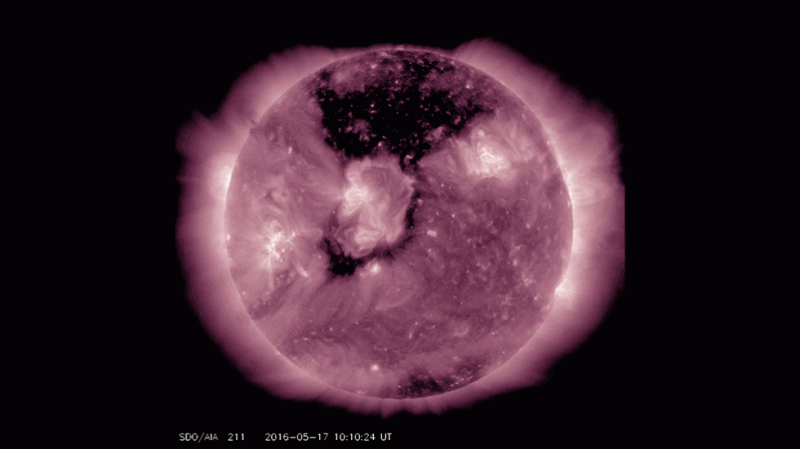
The dark area capping the northern polar region of the Sun is a coronal hole, a magnetically open area on the Sun from which high-speed solar wind escapes into space. Such high-speed solar wind streams can spark magnificent auroral displays on Earth when they collide with our planet’s magnetic field. These images were captured May 17-19, 2016, and the image on the stamp is from May 17. The images show the Sun in 211 Angstrom light, a wavelength of extreme ultraviolet light. This type of light is invisible to our eyes and is absorbed by Earth’s atmosphere, so it can only be seen by instruments in space.
Coronal Loops
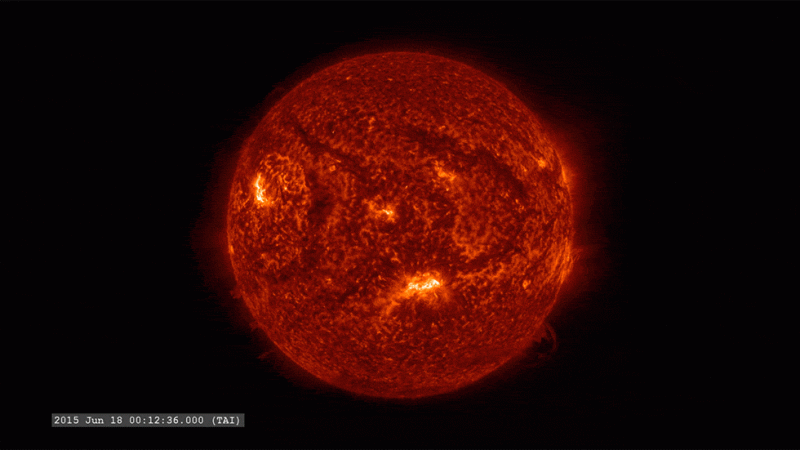
An extreme ultraviolet view of the Sun shows glowing loops of material
Visible on the lower right of the Sun is a prominence, with its bright arcs traced out by charged particles spiraling along the Sun’s magnetic field lines. Coronal loops are often found over sunspots and active regions, which are areas of intense and complex magnetic fields on the Sun. These images were captured on June 18, 2015, in light at 304 Angstroms, an extreme ultraviolet wavelength.
Solar Flare
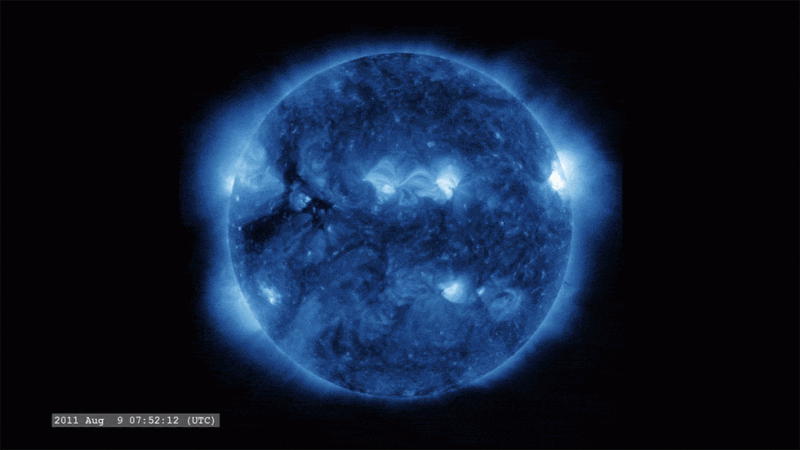
An extreme ultraviolet view of the Sun shows a bright solar flare
The bright flash on the Sun’s upper right is a powerful X-class solar flare. X-class flares are the most powerful type of solar flare, and these bursts of light and energy can disturb the part of Earth’s atmosphere where GPS and radio signals travel. These images were captured on Aug. 9, 2011, in extreme ultraviolet wavelength 335 Angstroms.
Active Sun
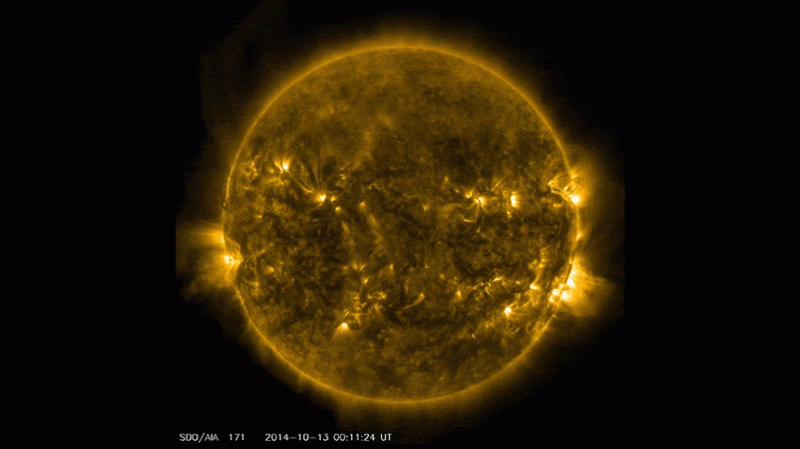
An extreme ultraviolet view shows the Sun dotted with active regions and loops
This view highlights the many active regions dotting the Sun’s surface. Active regions are areas of intense and complex magnetic fields on the Sun – linked to sunspots – that are prone to erupting with solar flares or explosions of material called coronal mass ejections. This image was captured on Oct. 8, 2014, in extreme ultraviolet wavelength 171 Angstroms.
Plasma Blast
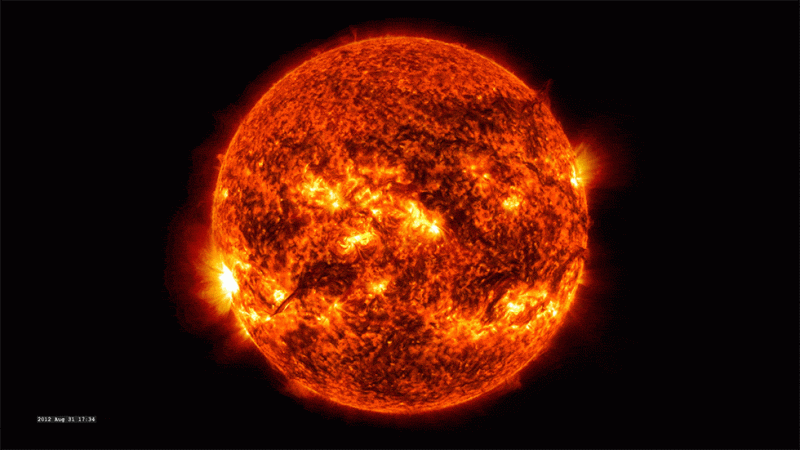
An extreme ultraviolet view of the Sun shows a tongue of solar material blasting off
These images show a burst of material from the Sun, called a coronal mass ejection. These eruptions of magnetized solar material can create space weather effects on Earth when they collide with our planet’s magnetosphere, or magnetic environment – including aurora, satellite disruptions, and, when extreme, even power outages. These images are a blend of extreme ultraviolet wavelengths 171 and 304 Angstroms, captured on Aug. 31, 2012.
Coronal Loops
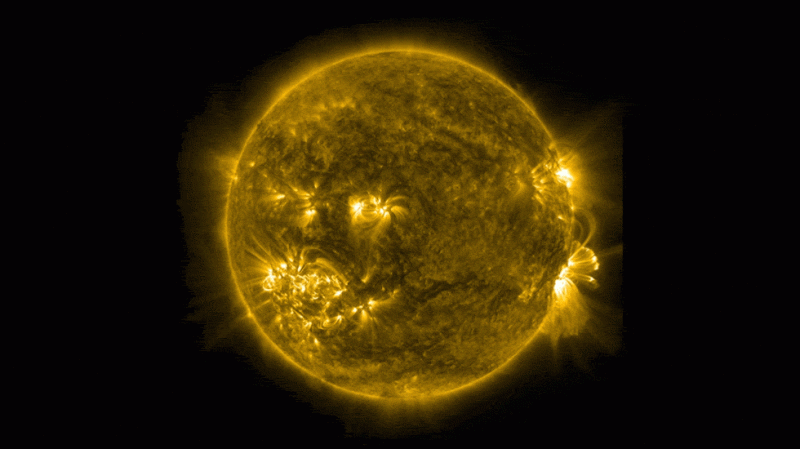
An extreme ultraviolet view of the Sun shows bright loops of material
These images show evolving coronal loops across the limb and disk of the Sun. Just days after these images were taken, the Sun unleashed a powerful X-class solar flare. These images were captured in extreme ultraviolet wavelength 171 Angstroms from July 8-10, 2012, and the image on the stamp is from July 9.
Sunspots
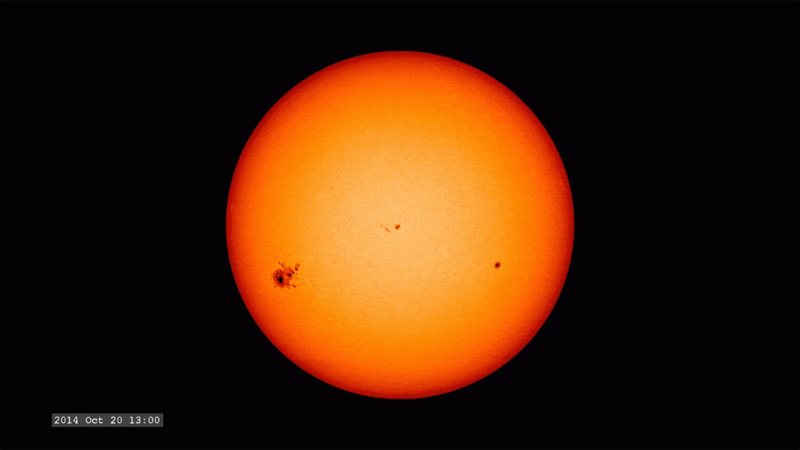
The Sun's surface is dotted with a cluster of dark sunspots
This view in visible light – the type of light we can see – shows a cluster of sunspots near the center of the Sun. Sunspots appear dark because they are relatively cool compared to surrounding material, a consequence of the way their extremely dense magnetic field prevents heated material from rising to the solar surface. These images were captured Oct. 20-26, 2014, and the frame on the stamp is from Oct. 23.
Plasma Blast
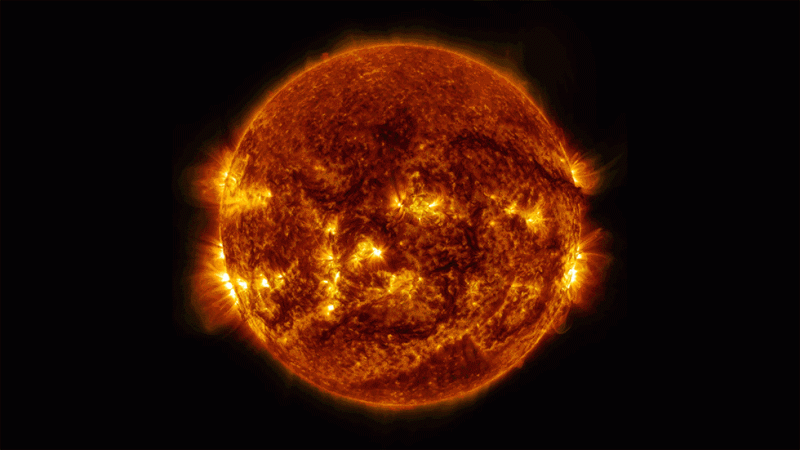
An extreme ultraviolet view of the Sun shows an eruption of material
These images show a burst of plasma from the lower right of the Sun, which happened in conjunction with a mid-level solar flare. These images are a blend of extreme ultraviolet wavelengths 171 and 304 Angstroms from Oct. 2, 2014.
Solar Flare
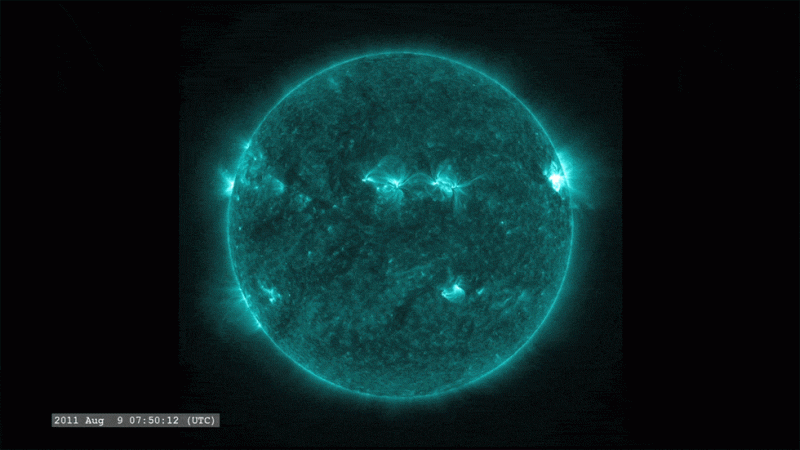
An extreme ultraviolet view of the Sun shows a bright solar flare
These images show another view of the Aug. 9, 2011, X-class solar flare featured in the blue-toned 335 Angstrom images. These images were captured in light at 131 Angstroms, an extreme ultraviolet wavelength.
Coronal Hole
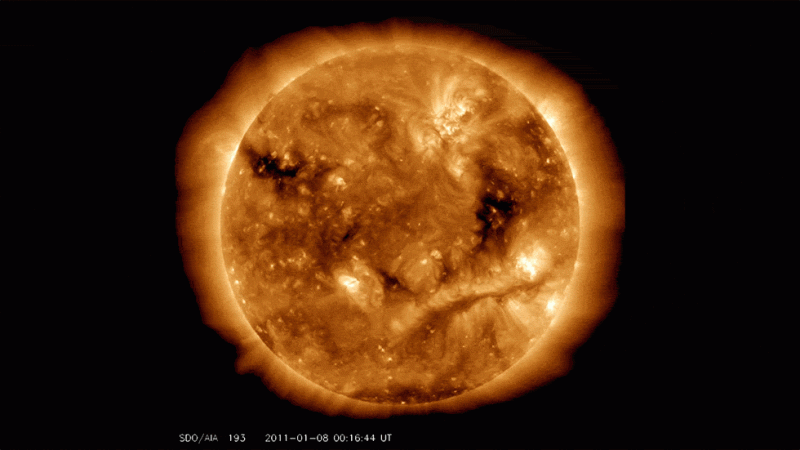
An extreme ultraviolet view of the Sun shows a pair of dark coronal holes
These images show a pair of coronal holes, one near the Sun’s equator and one at the Sun’s South Pole. These images were captured in extreme ultraviolet wavelength 193 Angstroms from Jan. 9-12, 2011, and the frame on the stamp is from Jan. 10.
SDO’s Atmospheric Imaging Assembly, which provides extreme ultraviolet views of the Sun, was designed and built by the Lockheed Martin Solar and Astrophysics Laboratory. The Helioseismic and Magnetic Imager was designed by Stanford University and built by the Lockheed Martin Solar and Astrophysics Laboratory. SDO was built and is operated and managed by Goddard for NASA’s Science Mission Directorate in Washington, D.C.
Source: nasa.gov